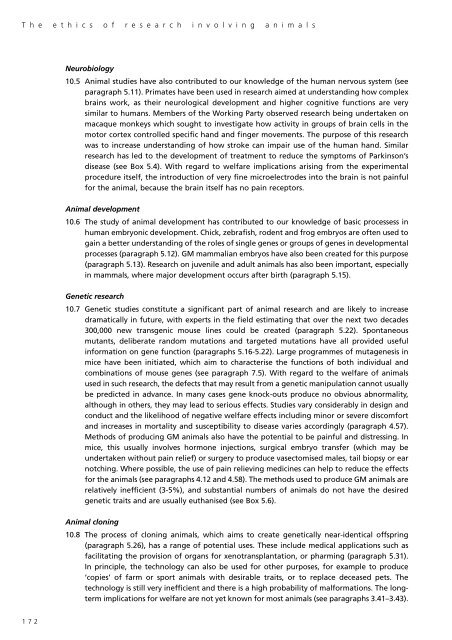The ethics of research involving animals - Nuffield Council on ...
The ethics of research involving animals - Nuffield Council on ...
The ethics of research involving animals - Nuffield Council on ...
Create successful ePaper yourself
Turn your PDF publications into a flip-book with our unique Google optimized e-Paper software.
T h e e t h i c s o f r e s e a r c h i n v o l v i n g a n i m a l s<br />
Neurobiology<br />
10.5 Animal studies have also c<strong>on</strong>tributed to our knowledge <str<strong>on</strong>g>of</str<strong>on</strong>g> the human nervous system (see<br />
paragraph 5.11). Primates have been used in <str<strong>on</strong>g>research</str<strong>on</strong>g> aimed at understanding how complex<br />
brains work, as their neurological development and higher cognitive functi<strong>on</strong>s are very<br />
similar to humans. Members <str<strong>on</strong>g>of</str<strong>on</strong>g> the Working Party observed <str<strong>on</strong>g>research</str<strong>on</strong>g> being undertaken <strong>on</strong><br />
macaque m<strong>on</strong>keys which sought to investigate how activity in groups <str<strong>on</strong>g>of</str<strong>on</strong>g> brain cells in the<br />
motor cortex c<strong>on</strong>trolled specific hand and finger movements. <str<strong>on</strong>g>The</str<strong>on</strong>g> purpose <str<strong>on</strong>g>of</str<strong>on</strong>g> this <str<strong>on</strong>g>research</str<strong>on</strong>g><br />
was to increase understanding <str<strong>on</strong>g>of</str<strong>on</strong>g> how stroke can impair use <str<strong>on</strong>g>of</str<strong>on</strong>g> the human hand. Similar<br />
<str<strong>on</strong>g>research</str<strong>on</strong>g> has led to the development <str<strong>on</strong>g>of</str<strong>on</strong>g> treatment to reduce the symptoms <str<strong>on</strong>g>of</str<strong>on</strong>g> Parkins<strong>on</strong>’s<br />
disease (see Box 5.4). With regard to welfare implicati<strong>on</strong>s arising from the experimental<br />
procedure itself, the introducti<strong>on</strong> <str<strong>on</strong>g>of</str<strong>on</strong>g> very fine microelectrodes into the brain is not painful<br />
for the animal, because the brain itself has no pain receptors.<br />
Animal development<br />
10.6 <str<strong>on</strong>g>The</str<strong>on</strong>g> study <str<strong>on</strong>g>of</str<strong>on</strong>g> animal development has c<strong>on</strong>tributed to our knowledge <str<strong>on</strong>g>of</str<strong>on</strong>g> basic processess in<br />
human embry<strong>on</strong>ic development. Chick, zebrafish, rodent and frog embryos are <str<strong>on</strong>g>of</str<strong>on</strong>g>ten used to<br />
gain a better understanding <str<strong>on</strong>g>of</str<strong>on</strong>g> the roles <str<strong>on</strong>g>of</str<strong>on</strong>g> single genes or groups <str<strong>on</strong>g>of</str<strong>on</strong>g> genes in developmental<br />
processes (paragraph 5.12). GM mammalian embryos have also been created for this purpose<br />
(paragraph 5.13). Research <strong>on</strong> juvenile and adult <str<strong>on</strong>g>animals</str<strong>on</strong>g> has also been important, especially<br />
in mammals, where major development occurs after birth (paragraph 5.15).<br />
Genetic <str<strong>on</strong>g>research</str<strong>on</strong>g><br />
10.7 Genetic studies c<strong>on</strong>stitute a significant part <str<strong>on</strong>g>of</str<strong>on</strong>g> animal <str<strong>on</strong>g>research</str<strong>on</strong>g> and are likely to increase<br />
dramatically in future, with experts in the field estimating that over the next two decades<br />
300,000 new transgenic mouse lines could be created (paragraph 5.22). Sp<strong>on</strong>taneous<br />
mutants, deliberate random mutati<strong>on</strong>s and targeted mutati<strong>on</strong>s have all provided useful<br />
informati<strong>on</strong> <strong>on</strong> gene functi<strong>on</strong> (paragraphs 5.16-5.22). Large programmes <str<strong>on</strong>g>of</str<strong>on</strong>g> mutagenesis in<br />
mice have been initiated, which aim to characterise the functi<strong>on</strong>s <str<strong>on</strong>g>of</str<strong>on</strong>g> both individual and<br />
combinati<strong>on</strong>s <str<strong>on</strong>g>of</str<strong>on</strong>g> mouse genes (see paragraph 7.5). With regard to the welfare <str<strong>on</strong>g>of</str<strong>on</strong>g> <str<strong>on</strong>g>animals</str<strong>on</strong>g><br />
used in such <str<strong>on</strong>g>research</str<strong>on</strong>g>, the defects that may result from a genetic manipulati<strong>on</strong> cannot usually<br />
be predicted in advance. In many cases gene knock-outs produce no obvious abnormality,<br />
although in others, they may lead to serious effects. Studies vary c<strong>on</strong>siderably in design and<br />
c<strong>on</strong>duct and the likelihood <str<strong>on</strong>g>of</str<strong>on</strong>g> negative welfare effects including minor or severe discomfort<br />
and increases in mortality and susceptibility to disease varies accordingly (paragraph 4.57).<br />
Methods <str<strong>on</strong>g>of</str<strong>on</strong>g> producing GM <str<strong>on</strong>g>animals</str<strong>on</strong>g> also have the potential to be painful and distressing. In<br />
mice, this usually involves horm<strong>on</strong>e injecti<strong>on</strong>s, surgical embryo transfer (which may be<br />
undertaken without pain relief) or surgery to produce vasectomised males, tail biopsy or ear<br />
notching. Where possible, the use <str<strong>on</strong>g>of</str<strong>on</strong>g> pain relieving medicines can help to reduce the effects<br />
for the <str<strong>on</strong>g>animals</str<strong>on</strong>g> (see paragraphs 4.12 and 4.58). <str<strong>on</strong>g>The</str<strong>on</strong>g> methods used to produce GM <str<strong>on</strong>g>animals</str<strong>on</strong>g> are<br />
relatively inefficient (3-5%), and substantial numbers <str<strong>on</strong>g>of</str<strong>on</strong>g> <str<strong>on</strong>g>animals</str<strong>on</strong>g> do not have the desired<br />
genetic traits and are usually euthanised (see Box 5.6).<br />
Animal cl<strong>on</strong>ing<br />
10.8 <str<strong>on</strong>g>The</str<strong>on</strong>g> process <str<strong>on</strong>g>of</str<strong>on</strong>g> cl<strong>on</strong>ing <str<strong>on</strong>g>animals</str<strong>on</strong>g>, which aims to create genetically near-identical <str<strong>on</strong>g>of</str<strong>on</strong>g>fspring<br />
(paragraph 5.26), has a range <str<strong>on</strong>g>of</str<strong>on</strong>g> potential uses. <str<strong>on</strong>g>The</str<strong>on</strong>g>se include medical applicati<strong>on</strong>s such as<br />
facilitating the provisi<strong>on</strong> <str<strong>on</strong>g>of</str<strong>on</strong>g> organs for xenotransplantati<strong>on</strong>, or pharming (paragraph 5.31).<br />
In principle, the technology can also be used for other purposes, for example to produce<br />
‘copies’ <str<strong>on</strong>g>of</str<strong>on</strong>g> farm or sport <str<strong>on</strong>g>animals</str<strong>on</strong>g> with desirable traits, or to replace deceased pets. <str<strong>on</strong>g>The</str<strong>on</strong>g><br />
technology is still very inefficient and there is a high probability <str<strong>on</strong>g>of</str<strong>on</strong>g> malformati<strong>on</strong>s. <str<strong>on</strong>g>The</str<strong>on</strong>g> l<strong>on</strong>gterm<br />
implicati<strong>on</strong>s for welfare are not yet known for most <str<strong>on</strong>g>animals</str<strong>on</strong>g> (see paragraphs 3.41–3.43).<br />
172
















